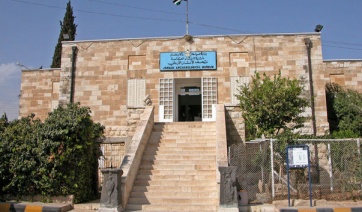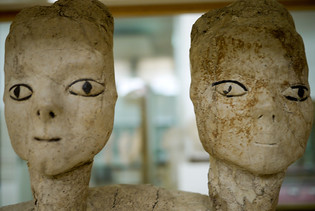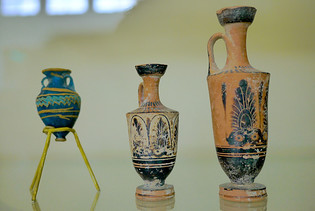

Location: Amman Citadel, Amman
The Jordan Archaeological Museum, located on the Amman Citadel (Jabal al-Qal’a) in the heart of Amman, Jordan, is a cornerstone of the nation’s cultural heritage. Established in 1951, it houses an extensive collection of artifacts spanning Jordan’s history from the Paleolithic period (ca. 1.5 million years ago) to the Islamic era (up to the 16th century CE). Positioned atop one of Amman’s seven hills, the museum offers not only a chronological journey through Jordan’s past but also panoramic views of the city’s historic core. Its proximity to key archaeological sites like the Umayyad Palace Complex and the Temple of Hercules enhances its significance as a hub for understanding Jordan’s multilayered history.
The Jordan Archaeological Museum was founded in 1951 under the
auspices of the Jordanian Department of Antiquities, a time when
Jordan was consolidating its national identity following
independence in 1946. The museum was established to preserve and
display artifacts unearthed from archaeological excavations across
the country, many of which were conducted by British, French, and
Jordanian teams in the early 20th century. Its location on the Amman
Citadel, a site inhabited since the Neolithic period (ca. 8500 BCE)
and central to Ammonite, Roman, Byzantine, and Umayyad
civilizations, was strategic, anchoring the museum in Jordan’s
historical heart.
The museum’s creation responded to the need
to centralize and protect Jordan’s archaeological treasures, which
were previously scattered or at risk of looting. It was designed to
showcase the country’s role as a crossroads of ancient
civilizations, from prehistoric hunter-gatherers to the Islamic
dynasties. Over the decades, the museum has grown through
contributions from excavations at sites like Petra, Jerash, Madaba,
and Qasr Amra, with artifacts ranging from everyday tools to
monumental statues. In 2014, some of its most significant pieces,
such as the ‘Ain Ghazal statues, were transferred to the newly
opened Jordan Museum in Ras al-Ayn for better preservation and
display, prompting discussions about the older museum’s future role.
Despite this shift, the Jordan Archaeological Museum remains a
vital repository, housing thousands of artifacts and serving as a
complement to the Citadel’s open-air ruins. Its modest size and
dated presentation reflect its mid-20th-century origins, but ongoing
efforts by the Department of Antiquities to digitize collections and
improve signage aim to modernize its appeal.


The Jordan Archaeological Museum is a modest, single-story building
constructed in 1951, designed to blend with the Citadel’s rugged,
historical ambiance. Its architecture is functional rather than ornate,
prioritizing the protection and display of artifacts over aesthetic
grandeur. Built from local limestone, the museum’s exterior harmonizes
with the Citadel’s ancient structures, such as the Umayyad Palace and
Temple of Hercules, while its compact footprint (approximately 1,000
square meters) ensures it does not overshadow the surrounding ruins.
Key architectural features include:
Exhibition Halls: The
interior consists of several interconnected rooms organized
chronologically, with artifacts grouped by historical period
(Paleolithic, Neolithic, Bronze Age, Iron Age, Hellenistic, Roman,
Byzantine, and Islamic). The halls are dimly lit to protect delicate
items, with simple display cases and minimalistic labeling in Arabic and
English.
Central Courtyard: A small outdoor courtyard connects the
museum to the Citadel’s open-air sites, serving as a transitional space
for visitors moving between indoor exhibits and outdoor ruins like the
Umayyad Palace’s audience hall.
Storage and Conservation Areas:
Behind-the-scenes rooms, not accessible to the public, house additional
artifacts and serve as workspaces for conservation and research,
reflecting the museum’s dual role as a display and research facility.
Rooftop Terrace: The museum’s flat roof, accessible during guided tours,
offers panoramic views of Amman’s seven hills, including the Roman
Theatre and downtown souks, enhancing its appeal as a scenic
destination.
The museum’s design is utilitarian, with concrete floors
and basic ventilation, reflecting its construction in a
resource-constrained era. Critics note its outdated
infrastructure—lacking climate control or interactive displays—compared
to modern institutions like the Jordan Museum. However, its simplicity
allows the artifacts to take center stage, and recent upgrades, such as
improved lighting and bilingual signage, aim to enhance the visitor
experience.
The Jordan Archaeological Museum’s collection spans over 1.5 million
years of Jordan’s history, with thousands of artifacts ranging from
stone tools to Islamic ceramics. While some of its most famous items,
like the ‘Ain Ghazal statues (the world’s oldest human figurines, ca.
7200 BCE), were moved to the Jordan Museum in 2014, the Citadel museum
retains a diverse and significant array of objects, many excavated from
local and regional sites. The collection is organized chronologically,
with thematic displays highlighting Jordan’s role in trade, religion,
and cultural exchange.
Key highlights include:
Prehistoric
Artifacts (Paleolithic to Neolithic, ca. 1.5 million–3500 BCE):
Flint
tools and hand axes from the Paleolithic period, showcasing early human
activity in the Jordan Valley.
Neolithic pottery and bone tools from
sites like Jericho and Beidha, reflecting the transition to agriculture
and settled communities.
Small plaster figurines and grinding stones,
illustrating early ritual and domestic life, though the iconic ‘Ain
Ghazal statues are now at the Jordan Museum.
Bronze and Iron Age
Artifacts (ca. 3500–500 BCE):
Ammonite statuettes and seals,
including representations of the god Milcom, from the Amman Citadel and
Tell Siran, highlighting the Ammonite Kingdom’s religious and
administrative practices.
Bronze weapons, jewelry, and pottery from
the Early Bronze Age city of Bab edh-Dhra, a major cemetery site near
the Dead Sea.
Iron Age ceramics with geometric patterns, reflecting
trade with neighboring Moab, Edom, and Israel.
Hellenistic and
Nabataean Artifacts (ca. 300 BCE–106 CE):
Nabataean pottery and
incense burners from Petra, showcasing the kingdom’s wealth from the
incense trade.
Hellenistic-style figurines and coins, reflecting
Greek influence after Alexander the Great’s conquests.
Inscribed
ostraca (pottery shards) from Khirbet al-Mudayna, offering insights into
Nabataean administration.
Roman and Byzantine Artifacts (ca. 63
BCE–636 CE):
Marble statues and reliefs from Jerash (Gerasa) and
Gadara, including fragments of deities and emperors, demonstrating Roman
artistic sophistication.
Mosaics from Madaba and Umm ar-Rasas,
depicting Christian motifs and daily life, reflecting Byzantine Jordan’s
religious diversity.
Glassware, lamps, and coins from Philadelphia
(Amman), illustrating urban life in the Roman Decapolis.
Umayyad
and Islamic Artifacts (ca. 661–1516 CE):
Stucco fragments and
ceramics from the Umayyad Palace Complex, featuring geometric and
vegetal motifs that influenced later Islamic art.
Abbasid and Fatimid
coins, glassware, and pottery, showcasing Amman’s role in early Islamic
trade networks.
Mamluk-era metalwork and inscribed stones, marking
the Citadel’s reuse in the medieval period.
Notable Artifacts:
Ammonite Inscriptions: Stone seals and ostraca with early Semitic
script, providing evidence of Ammonite literacy and governance.
Roman
Funerary Busts: Carved limestone busts from Amman’s necropolis, offering
glimpses into Roman-era portraiture.
Byzantine Jewelry: Gold earrings
and necklaces from Christian tombs, reflecting wealth and craftsmanship.
Umayyad Stucco Panels: Intricate rosettes and palmettes from the
palace’s audience hall, showcasing early Islamic decorative arts.
The museum’s collection, while comprehensive, is displayed in a
somewhat cramped and dated manner, with glass cases and minimal
interactive elements. Labels provide basic context, but their brevity
can frustrate visitors seeking deeper explanations. The transfer of
high-profile items to the Jordan Museum has reduced the Citadel museum’s
draw, yet its proximity to the Umayyad Palace and Temple of Hercules
ensures it remains integral to the Citadel experience.
The Jordan Archaeological Museum is a vital institution for
understanding Jordan’s role as a cultural crossroads, bridging
prehistoric, ancient, and Islamic civilizations. Its significance spans
several dimensions:
Preserving Jordan’s Heritage: The museum
safeguards artifacts from sites across Jordan, protecting them from
looting and environmental damage. Its establishment in 1951 marked a
national commitment to cultural preservation, aligning with Jordan’s
post-independence identity-building.
Chronicling Human History: The
collection spans from the Paleolithic to the Ottoman period,
illustrating Jordan’s continuous habitation and its role in major
historical shifts, such as the Neolithic Revolution, the rise of Iron
Age kingdoms, and the spread of Christianity and Islam.
Highlighting
Regional Influence: Artifacts from the Ammonite, Nabataean, Roman, and
Umayyad periods underscore Jordan’s position along trade routes like the
King’s Highway and Via Traiana Nova, connecting Egypt, Mesopotamia, and
Arabia. The museum’s Nabataean and Umayyad items, in particular,
highlight Jordan’s contributions to global cultural heritage.
Educational Role: As a resource for scholars, students, and tourists,
the museum supports research and public education. Its artifacts have
been studied in publications like The Annual of the Department of
Antiquities of Jordan, advancing knowledge of Levantine archaeology.
Tourist Attraction: Part of the Amman Citadel, a top-rated site on
Tripadvisor and UNESCO’s tentative World Heritage list, the museum draws
visitors for its historical depth and scenic views. Posts on X describe
it as “a treasure trove of Jordan’s past,” reflecting its appeal to
history enthusiasts.
Cultural Identity: By showcasing Ammonite,
Nabataean, and Islamic artifacts, the museum reinforces Jordan’s diverse
heritage, complementing modern landmarks like the King Abdullah I
Mosque. It counters narratives that prioritize biblical or Roman
history, emphasizing local cultures like the Ammonites and Nabataeans.
However, the museum’s focus on elite artifacts (e.g., royal seals,
Umayyad stucco) may marginalize the stories of ordinary people, such as
farmers or artisans, whose lives are less represented. Its dated
presentation also risks underrepresenting Jordan’s archaeological
richness compared to flashier institutions like the Jordan Museum or
Petra’s visitor center.
Location: Amman Citadel, Jabal al-Qal’a, central Amman, Jordan. The
museum is near the Umayyad Palace Complex and Temple of Hercules,
accessible via the Citadel’s main entrance on Al-Qal’a St.
Access:
Easily reached by taxi (request “Jabal al-Qal’a”; ~2–3 JOD from
downtown). Public buses serve Raghadan Bus Station (1.5 km away),
followed by a 10-minute uphill walk or short taxi ride. Free parking is
available on-site, though spaces are limited.
Opening Hours:
Typically 8:00 AM–6:00 PM (April–October), 8:00 AM–4:00 PM
(November–March), closed during heavy rain. Friday hours may be shorter
(e.g., 10:00 AM–4:00 PM). Confirm via the Jordanian Ministry of Tourism
(https://myjordanjourney.com).
Admission: Included in the Citadel
entry fee (3 JOD for non-residents, free for children under 12 and
Jordanian residents with ID). The Jordan Pass (72–80 JOD) covers the
Citadel and other sites like Petra and Jerash. Guided tours (~10–20 JOD)
are available through operators like Jordan Select Tours
(https://jordan-travel.com).
Best Time to Visit: Spring (March–May)
or fall (September–November) for mild temperatures (15–25°C/59–77°F).
Early morning (8:00–10:00 AM) or late afternoon (3:00–5:00 PM) avoids
summer heat (up to 30°C/86°F) and offers ideal lighting for Citadel
views.
Visit Duration: 45 minutes to 1 hour for the museum alone; 2–3
hours to explore the Citadel’s Umayyad Palace, Temple of Hercules, and
Byzantine Church. Guided tours enhance the experience, especially for
non-specialists.
Nearby Attractions: Temple of Hercules, Umayyad
Palace, and Byzantine Church (on-site); Roman Theatre (1.8 km); Grand
Husseini Mosque (2 km); Rainbow Street (3 km); Abu Darwish Mosque (2.5
km). Combine with a downtown walking tour for souks and eateries like
Hashem Restaurant (2 km).
Accessibility Features: The museum’s
interior is relatively flat but lacks ramps, and the Citadel’s rocky
terrain limits wheelchair access. The audience hall and gateway nearby
are reachable with assistance. Wear sturdy shoes for uneven paths.
Restrooms and shaded benches are available, but bring water, as no food
vendors are on-site.
Tips: Use a guide or audio guide (available at
the Citadel entrance) for context, as labels are brief. Photography is
allowed without flash. Check for cultural events at the Umayyad Palace’s
gateway, listed on Visit Jordan (https://www.visitjordan.com).
The
museum’s hilltop location offers stunning views of Amman’s Roman
Theatre, seven hills, and skyline, making it a highlight for
photographers. Visitors often pair it with the Citadel’s ruins for a
comprehensive historical experience.
While the Jordan Archaeological Museum is a vital cultural asset,
several aspects invite critical scrutiny:
Outdated Presentation:
The museum’s 1950s design, with basic display cases and minimal
interactivity, feels dated compared to modern institutions like the
Jordan Museum. Limited climate control endangers fragile artifacts, and
brief labels can frustrate visitors, as noted in Tripadvisor reviews
calling it “interesting but old-fashioned.”
Artifact Transfers: The
relocation of marquee items like the ‘Ain Ghazal statues to the Jordan
Museum in 2014 has diminished the Citadel museum’s draw, raising
questions about its future role. Some argue it risks becoming a
secondary attraction, despite its historical significance and prime
location.
Narrative Bias: The collection emphasizes elite objects
(e.g., royal seals, Umayyad stucco), potentially sidelining the lives of
ordinary people, such as Neolithic farmers or Roman artisans. Greater
focus on domestic artifacts could offer a more inclusive narrative, as
suggested in archaeological critiques.
Accessibility Barriers: The
Citadel’s uneven terrain and the museum’s lack of ramps exclude visitors
with mobility issues, despite Jordan’s push for inclusive tourism.
Virtual tours or improved pathways could address this, as recommended in
tourism forums.
Urban Encroachment: The Citadel’s hilltop setting is
juxtaposed against Amman’s modern sprawl, with traffic noise and
construction disrupting the historical ambiance, as noted by visitors on
Reddit. This contrasts with isolated sites like Qasr Amra, which retain
a stronger sense of place.
Underutilized Potential: The museum’s
research facilities and unexhibited artifacts suggest untapped potential
for academic and public engagement. Digitizing collections or hosting
temporary exhibits could elevate its profile, as seen in successful
models like the Petra Museum.
These critiques highlight the need for
modernization, inclusivity, and a balanced narrative to ensure the
museum remains relevant amid Jordan’s evolving tourism landscape.
Integrating stories of non-elite communities and leveraging digital
tools could enhance its appeal, aligning with global museum trends.